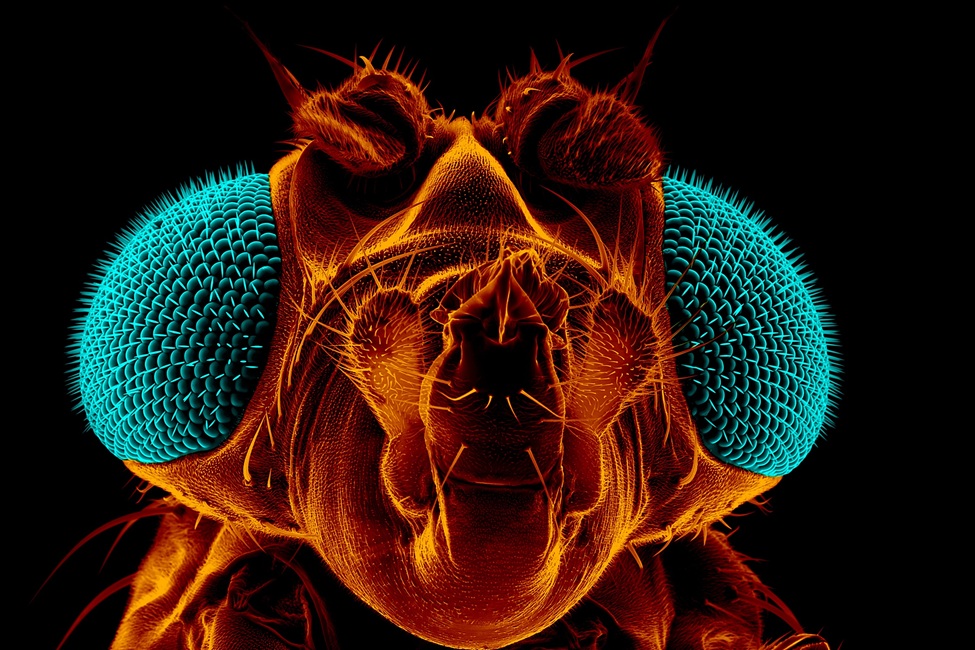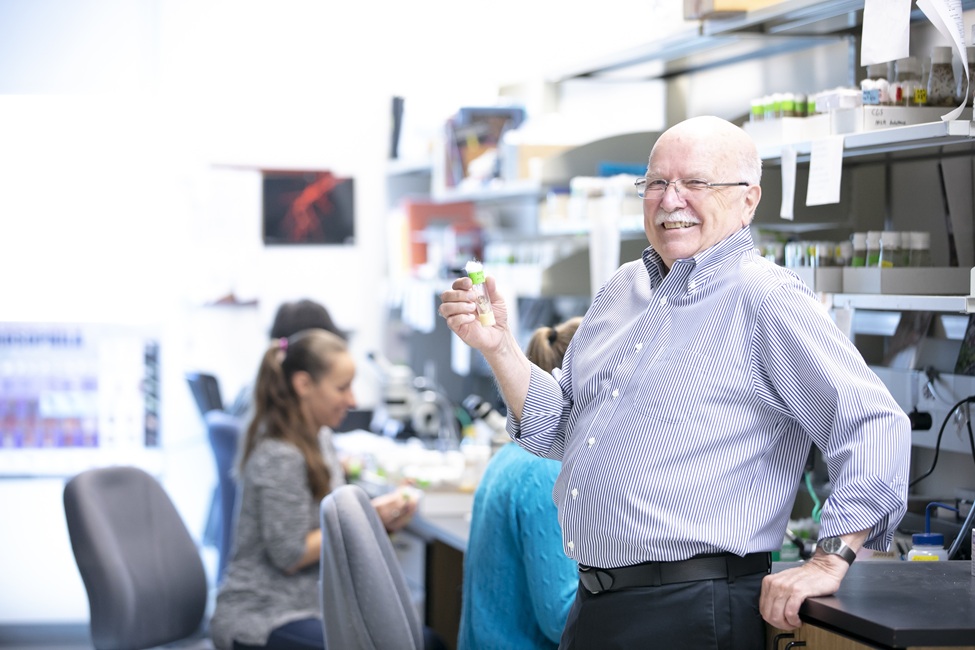'Frazzled' Fruit Flies Help Unravel How Neural Circuits Stay Wired

Extreme close-up of a fruit fly (Drosophila melanogaster) using scanning electron microscopy.
Study Snapshot: Florida Atlantic University neuroscientists have identified a surprising new role for a protein called “Frazzled” (DCC in humans) in helping fruit fly neurons connect and communicate at lightning speed. Studying the Giant Fiber System, which controls the flies’ rapid escape reflex, they found that when Frazzled is missing or mutated, neurons fail to form proper electrical connections, slowing neural responses and weakening muscle control. Using genetic tools, the researchers showed that the intracellular portion of Frazzled alone could restore normal communication, revealing that this part of the protein regulates the genes needed to build gap junctions.
By combining genetics, imaging, physiology and computational modeling, the team demonstrated how even small changes in gap junction density can alter the precision of neural signals. The work shows that Frazzled not only guides neurons to their correct targets but also ensures they form stable, functional synapses once they arrive – a dual role that appears conserved across species. This discovery provides new insight into the molecular rules that keep nervous systems, from flies to humans, reliably wired.
Florida Atlantic University neuroscientists have uncovered a surprising role for a protein named “Frazzled” (known as DCC in mammals) in the nervous system of fruit flies, showing how it helps neurons connect and communicate with lightning speed. The discovery sheds light on the fundamental mechanisms that ensure neurons form reliable connections, or synapses, a process essential for all nervous systems, from insects to humans.
In the study, researchers focused on the Giant Fiber (GF) System of Drosophila, a neural circuit that controls this fruit fly’s rapid escape reflex. With this work, the team has not only revealed a key molecular player in fruit fly neural circuits but also demonstrated the power of combining genetics, imaging, physiology and computational modeling to uncover how brains stay wired – and what happens when they don’t.
The results, published in the journal eNeuro, reveal that when Frazzled is missing or mutated, the system falters: neurons fail to form proper electrical connections, the fly’s neural responses slow down, and communication between the GF neurons and the muscles they control weakens.
These defects are linked to a loss of gap junctions, tiny channels that allow neurons to transmit signals directly and rapidly. In particular, the team found that the loss of a protein called shaking-B(neural+16), which forms these junctions in the presynaptic terminals, underlies much of the misfiring.
To understand Frazzled’s precise role, the researchers used a genetic tool known as the UAS-GAL4 system to reintroduce different pieces of the Frazzled protein into mutant flies. Strikingly, just the intracellular portion of Frazzled – the part inside the neuron that can influence gene expression – was enough to restore both the structure of the synapses and the speed of neuronal communication. When this portion was disrupted, such as by deleting a key domain called P3 or mutating a crucial site within it, the rescue failed, indicating that Frazzled’s control of gene activity is essential for building gap junctions.
Beyond laboratory experiments, the team also created a computational model of the GF System, simulating how the number of gap junctions affects the neurons’ ability to fire reliably. The model confirmed that even small changes in gap junction density can drastically alter the speed and precision of neural signals.
“The combination of experimental and computational work allowed us to see not just that Frazzled matters, but exactly how it shapes the connections that let neurons talk to each other,” said Rodney Murphey, Ph.D., senior author and a professor of biological sciences in the FAU Charles E. Schmidt College of Science. “Our next steps are to explore whether similar mechanisms control neural circuits in other species, including mammals, and to see how this might influence learning, memory or even repair after injury.”
Interestingly, while Frazzled has long been studied as a guidance molecule – helping neurons grow along the correct paths – the study revealed that its intracellular domain also directly regulates synapse formation. Flies lacking Frazzled often showed neurons that grew in random directions, failing to reach their targets. Restoring the intracellular domain corrected many of these guidance errors, demonstrating a dual role for Frazzled in both wiring neurons and fine-tuning their communication.
This work also draws parallels to other organisms. Similar proteins in worms and vertebrates have been shown to influence chemical synapses, suggesting that Frazzled and its relatives may play a broadly conserved role in shaping neural networks. By showing how a single protein controls both the physical and functional aspects of electrical synapses, this study opens a window into the fundamental rules governing nervous system assembly.
“Understanding how neurons form reliable connections is a central question in neuroscience,” Murphey said. “Frazzled gives us a clear handle on one piece of that puzzle. Our findings could inform future studies of neural development, neurodegenerative diseases and strategies to repair damaged circuits.”
Study co-authors are first author Juan Lopez, Ph.D., a postdoctoral researcher in the Charles E. Schmidt College of Science; Jana Boerner, Ph.D., managing director of the Advanced Cell Imaging Core within the FAU Stiles-Nicholson Brain Institute; Kelli Robbins, research staff in FAU’s Department of Biological Sciences; and Rodrigo Pena, Ph.D., an assistant professor of biological sciences in the Charles E. Schmidt College of Science.

Rodney Murphey, Ph.D., senior author and a professor of biological sciences in the FAU Charles E. Schmidt College of Science.
-FAU-
Latest News Desk
- FAU Innovation Pilot Awards Drive Faculty Research from Lab to MarketThe FAU pilot program offers $500 to $15,000 in seed funding to help researchers turn early discoveries into market-ready technologies, fostering prototypes, industry partnerships and real-world impact.
- Nearly 70 FAU Faculty Named Among World's Top 2% of ScientistsNearly 70 FAU faculty are ranked among the world's top 2% of scientists by Stanford-Elsevier, recognizing their global research impact across 22 fields and 174 subfields from engineering to humanities.
- FAU to Celebrate 'Homecoming: Paradise Island'Florida Atlantic University will celebrate "Homecoming: Paradise Island" beginning Thursday, Oct. 30 through Saturday, Nov. 8.
- FAU Researchers Make Great 'Strides' in Gait Analysis TechnologyA first-of-its-kind study explored whether more accessible technologies such as a 3D depth camera could accurately measure how people walk, offering a practical alternative to traditional gait analysis tools.
- FAU Establishes Professorship in Jain StudiesThe Department of Philosophy recently announced the establishment of the Bhagavan Sambhavnath Endowed Professorship in Jain Studies.
- FAU Historian Traces How U.S. Nursing Homes Evolved into Big BusinessA historian explores how the Americana Corporation shaped modern nursing homes, revealing how architecture tied aging, care and profit into a system that still defines long-term care in the U.S. today.






